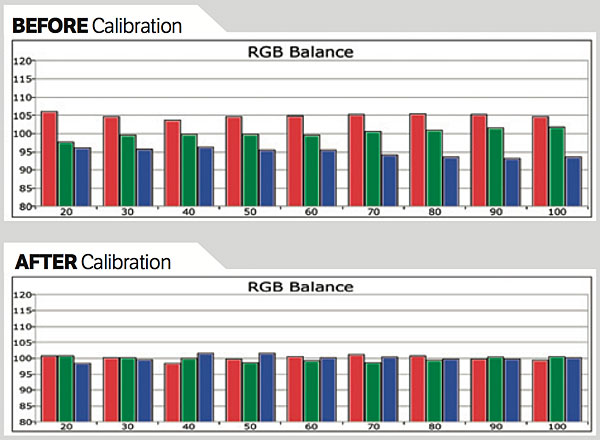LG 55EA9800 3D OLED HDTV Test Bench
Full-On/Full-Off Contrast Ratio: Infinite
All the following measurements were made in Expert Picture Mode. With the Contrast and OLED Light controls set to produce a peak white level of 29.7 ft-L and the Brightness control set to 51, the black level was immeasurably low, resulting in an effectively infinite contrast ratio. But the Brightness (black level) setting is critical to this result. When I raised the control by one step, to 52, the black level rose to a quite visible 0.0074 ft-L, dropping the full-on/full-off contrast ratio to 4,014:1. To minimize the occasional appearance of the set’s poor dark-gray non-uniformity mentioned in the review, I performed much of the reviewing and the remaining measurements with a Brightness setting of 50.

In the Vivid mode, without calibration but with the Contrast control reduced to allow 2% headroom at the top end, the peak white level was 94.6 ft-L.
All of the calibrations here were performed with just the two-point White Balance controls, using (as we always do) white-window test patterns. The 2D pre-calibration color-tracking results shown were taken in the 2D THX setting. Pre-calibration, the minimum Delta E was 1.32 at 20% brightness, the high 7.88 at 100%, and the average 4.32. The peak white level in the (non-adjustable) THX mode was 40 ft-L. After calibration (Warm2 Color Temperature setting, Expert 1 preset), the high Delta E reading was 1.39 at 70% and the average 0.76. (Delta E is a figure of merit that indicates how close the result is to the BT709/Rec. 709 HD standard. A Delta E below 3 is generally considered excellent and visually indistinguishable from perfect.)
The 2D color gamut (not shown) was very good, even without employing the color management system (which proved ineffective). The average color gamut Delta E was 2.71, and apart from blue (an outlier with a Delta E of 6.21) the high was 3.56 on yellow.
For 3D (charts not shown), the pre-calibration color (THX 3D Mode) was fair, but it could be improved significantly by calibration in an Expert mode. The white balance Delta E was 3.48 before, 1.92 after. The post-calibration 3D color gamut Delta E measured 3.22.
At a 2.4 setting of the Gamma control, the 2D gamma averaged 2.25, with a minimum value of 2.16 at 20% brightness and a maximum of 2.3 at 40%. The average 3D gamma in this same setting was 2.22.

The LG OLED drew considerably less power than my reference 65-inch Panasonic does, depending on the source. With a checkerboard pattern, the Panasonic drew 3.8x the power (roughly adjusted to account for the size difference—45 W/sq.ft. for the Panasonic from 563 W total, 11.7 W/sq.ft for the OLED from 105 W total). With a 30% brightness window pattern, the difference decreased substantially, to 1.2x more for the plasma. This is a major advantage for OLED.—TJN













































